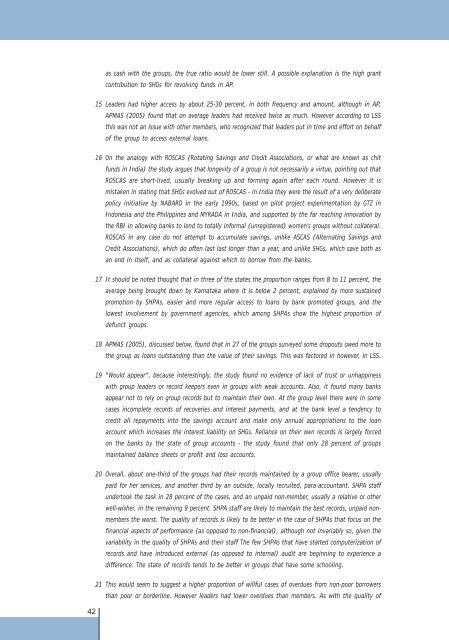Download sector_report1.pdf - Microfinance and Development ...
Download sector_report1.pdf - Microfinance and Development ...
Download sector_report1.pdf - Microfinance and Development ...
Create successful ePaper yourself
Turn your PDF publications into a flip-book with our unique Google optimized e-Paper software.
as cash with the groups, the true ratio would be lower still. A possible explanation is the high grant<br />
contribution to SHGs for revolving funds in AP.<br />
15 Leaders had higher access by about 25-30 percent, in both frequency <strong>and</strong> amount, although in AP,<br />
APMAS (2005) found that on average leaders had received twice as much. However according to LSS<br />
this was not an issue with other members, who recognized that leaders put in time <strong>and</strong> effort on behalf<br />
of the group to access external loans.<br />
16 On the analogy with ROSCAS (Rotating Savings <strong>and</strong> Credit Associations, or what are known as chit<br />
funds in India) the study argues that longevity of a group is not necessarily a virtue, pointing out that<br />
ROSCAS are short-lived, usually breaking up <strong>and</strong> forming again after each round. However it is<br />
mistaken in stating that SHGs evolved out of ROSCAS - in India they were the result of a very deliberate<br />
policy initiative by NABARD in the early 1990s, based on pilot project experimentation by GTZ in<br />
Indonesia <strong>and</strong> the Philippines <strong>and</strong> MYRADA in India, <strong>and</strong> supported by the far reaching innovation by<br />
the RBI in allowing banks to lend to totally informal (unregistered) women's groups without collateral.<br />
ROSCAS in any case do not attempt to accumulate savings, unlike ASCAS (Alternating Savings <strong>and</strong><br />
Credit Associations), which do often last last longer than a year, <strong>and</strong> unlike SHGs, which save both as<br />
an end in itself, <strong>and</strong> as collateral against which to borrow from the banks.<br />
17 It should be noted thought that in three of the states the proportion ranges from 8 to 11 percent, the<br />
average being brought down by Karnataka where it is below 2 percent, explained by more sustained<br />
promotion by SHPAs, easier <strong>and</strong> more regular access to loans by bank promoted groups, <strong>and</strong> the<br />
lowest involvement by government agencies, which among SHPAs show the highest proportion of<br />
defunct groups.<br />
18 APMAS (2005), discussed below, found that in 27 of the groups surveyed some dropouts owed more to<br />
the group as loans outst<strong>and</strong>ing than the value of their savings. This was factored in however, in LSS.<br />
19 "Would appear", because interestingly, the study found no evidence of lack of trust or unhappiness<br />
with group leaders or record keepers even in groups with weak accounts. Also, it found many banks<br />
appear not to rely on group records but to maintain their own. At the group level there were in some<br />
cases incomplete records of recoveries <strong>and</strong> interest payments, <strong>and</strong> at the bank level a tendency to<br />
credit all repayments into the savings account <strong>and</strong> make only annual appropriations to the loan<br />
account which increases the interest liability on SHGs. Reliance on their own records is largely forced<br />
on the banks by the state of group accounts - the study found that only 28 percent of groups<br />
maintained balance sheets or profit <strong>and</strong> loss accounts.<br />
20 Overall, about one-third of the groups had their records maintained by a group office bearer, usually<br />
paid for her services, <strong>and</strong> another third by an outside, locally recruited, para-accountant. SHPA staff<br />
undertook the task in 28 percent of the cases, <strong>and</strong> an unpaid non-member, usually a relative or other<br />
well-wisher, in the remaining 9 percent. SHPA staff are likely to maintain the best records, unpaid nonmembers<br />
the worst. The quality of records is likely to be better in the case of SHPAs that focus on the<br />
financial aspects of performance (as opposed to non-financial), although not invariably so, given the<br />
variability in the quality of SHPAs <strong>and</strong> their staff The few SHPAs that have started computerization of<br />
records <strong>and</strong> have introduced external (as opposed to internal) audit are beginning to experience a<br />
difference. The state of records tends to be better in groups that have some schooling.<br />
42<br />
21 This would seem to suggest a higher proportion of willful cases of overdues from non-poor borrowers<br />
than poor or borderline. However leaders had lower overdues than members. As with the quality of














